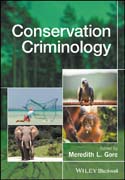
This important new text introduces conservation criminology as the interdisciplinary study of environmental exploitation and risks at the intersection of human and natural systems. Taking an interdisciplinary approach, the book enhances understanding of the various human and organizational behaviors that pose risks to the environment, humans, and drive conservation crime. As human population growth, global market economies, climate change, deforestation, and illegal exploitation of natural resources continue to increase, academic research from numerous disciplines is needed to address these challenges. Conservation Criminology promotes thinking about how unsustainable natural resources exploitation is a cause and a consequence of social conflict. Case studies profiled in the book demonstrate this cause and effect type situation, as well as innovative approaches for reducing risks to people and the environment. This text encourages readers to consider how humans behave in response to environmental risks and the various mechanisms that constitute effective and ineffective approaches to enforcement of wildlife crimes, including environmental and conservation policy. Case studies from the USA, Latin America, Africa, and Asia highlight corruption in conservation, global trade in electronic waste, illegal fishing, illegal logging, human–wildlife conflict, technology and space, water insecurity, wildlife disease, and wildlife poaching. Taken together, chapters expand the reader s perspective and employ tools to understand and address environmental crimes and risks, and to provide novel empirical evidence for positive change. With established contributors providing interdisciplinary and global perspectives, this book establishes a foundation for the emerging field of conservation criminology. INDICE: Chapter 1: Global Risks, Conservation and Criminology Meredith L. Gore .Section 1: Conceptual Advancements in Conservation Criminology .Chapter 2: Conservation Crime Science Jessica S. Kahler and Meredith L. Gore .Chapter 3: Deterrence, Legitimacy and Wildlife Crime in Protected Areas William D. Moreto and Jacinta M. Gau .Section 2: Case Studies and Examples .Chapter 4: Governance for Conservation Risks and Crime Mark A. Axelrod, Austin Flowers, Katherine Groff and Julia Novak Colwell .Chapter 5: Gaining Compliance and Cooperation with Regulated Wildlife Harvest Brent A. Rudolph and Shawn J. Riley .Chapter 6: Corruption and Organized Crime in Conservation Aksel Sundströmand Tanya Wyatt .Chapter 7: Problem–Oriented Policing for Natural Resource Conservation Mark G. Gibson .Chapter 8: Wildlife Tourism, Global Risks, and Crime Jessica Bell Rizzolo .Section 3: Models and Innovations .Chapter 9: Innovations in Technology Support Wildlife Crime Detection, Deterrence and Enforcement Heidi Kretser, Emma Stokes, Serge Wich, David Foran and Alexa Montefiore .Chapter 10: PAWS: Game Theory Based Protection Assistant for Wildlife Security Fei Fang, Benjamin Ford, Rong Yang, Milind Tambe and Andrew Lemieux .Chapter 11: Estimating Poaching Opportunity and Potential Adrian Treves, Christine Browne–Nunez, Jamie Hogberg, Jens Kalrsson Frank, Lisa Naughton–Treves, Nicole Rust and Zachary Voyles
- ISBN: 978-1-118-93548-4
- Editorial: Wiley–Blackwell
- Encuadernacion: Cartoné
- Páginas: 248
- Fecha Publicación: 02/05/2017
- Nº Volúmenes: 1
- Idioma: Inglés
